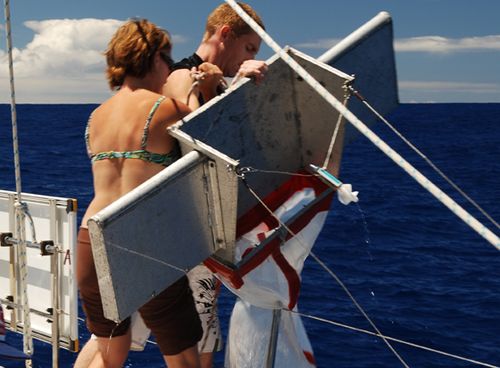
Despite what you might have heard, there are no huge, visually striking debris fields of plastic shopping bags and PET bottles swirling around the Great Pacific Garbage Patch. But if that's the good news, the bad news is much worse: there are in fact five different garbage patches, or gyres, formed by wind-driven ocean currents, and they are filled with photo-degraded plastic bits that are potentially far more dangerous to marine life and insidious than barges of plastic trash would be.
Oh, and every once in a while one will find huge gnarly balls of discarded fishing nets and bottles and buckets and toothbrushes bopping along the currents.
These were among the findings that Leslie Moyer and Carolynn Box, research aids with the , shared with a packed house at 's North Point retail store in San Francisco on Wednesday. Five Gyres is a research initiative that has spent the past few years sailing into the world's subtropical gyres to collect water samples and measure the amount of plastic pollution within each.
Over the course of eight different expeditions, the 5 Gyres team has taken 237 samples of surface water while sailing through these massive gyres. Of those samples, only two have revealed zero traces of plastic pollution. “As you approach the center of the gyre, the density of plastic increases,” said Moyer.
You've likely seen images of seabird carcasses filled with plastic bottle caps and other debris that the animals mistake for food. But that's not the only way plastic pollution harms marine life. While conventional plastic, used in everything from packaging to cigarette lighters to toys to shipping crates, won't biodegrade, it will photo-degrade over years and decades of exposure to ultraviolet radiation from the sun and wave action. Eventually, plastic breaks down into tiny pellets that are ingested by marine life. This material then bioaccumulates up the marine food chain.╠ř
There is still much to learn about how ubiquitous plastic pollution is impacting the ocean, its inhabitants, and, by extension, us. In an effort better understand the problem, 5 Gyres collects gyre samples using a customized trawl. The water is filtered though a fine mesh bag, which floats along at a depth of 25 centimeters as the boat travels at 2 to 3 knots. The collected data is shared with a marine science research organization called Algalita, which was founded by Charles Moore who is credited with first discovering accumulated plastic pollution in the a gyre in the North Pacific, which later became known as the Great Pacific Garbage Patch.
Aside from conducting research, 5 Gyres is also trying to broadcast the issues surrounding plastic pollution and attempting to mitigate its toll on the oceans, through education and coastal clean-up efforts. “Coastal clean-up is gyre cleanup, since all the plastic you see along a beach will eventually end up in a gyre” if we don't get it first, explained Box.╠ř
Also filed under the tired but still important╠ř “what you can do” rubric is to reduce demand for plastic.╠ř Anyone who uses plasticÔÇöthat would be just about everyone, everywhereÔÇöcould drastically reduce the amount of plastic they purchase (especially single-use packaging, hello water bottle).╠ř
But another way anyone can help is by taking part in the research effort as a citizen scientist. Marcus Eriksen, who co-founded 5 Gyres, developed the trawls that the researcher use, and has recently come up with a scaled down version that can be deployed from a kayak. The more data that 5 Gyres can collect, the better, says Eriksen.╠ř
If you're looking for something a bit more intense, 5 Gyres still needs some crew members for its 2012 expeditions, which will include a trip into the debris field created by Japan's 2011 tsunami. If you're interested in seeing how you can take part, go to .╠ř
–Mary Catherine O'Connor
╠ř